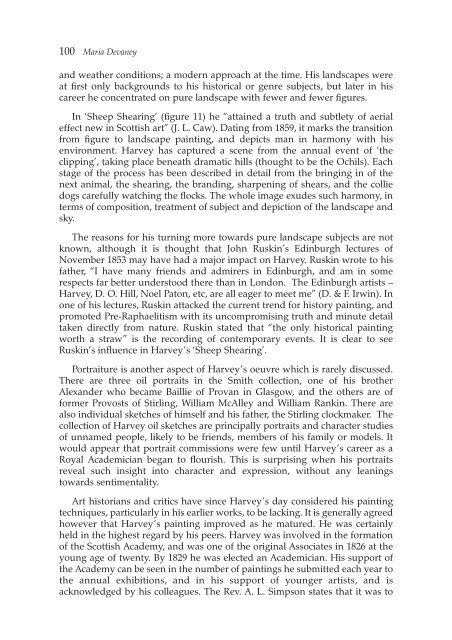the Forth Naturalist Historian - Forth Naturalist and Historian ...
the Forth Naturalist Historian - Forth Naturalist and Historian ...
the Forth Naturalist Historian - Forth Naturalist and Historian ...
You also want an ePaper? Increase the reach of your titles
YUMPU automatically turns print PDFs into web optimized ePapers that Google loves.
100 Maria Devaney<br />
<strong>and</strong> wea<strong>the</strong>r conditions; a modern approach at <strong>the</strong> time. His l<strong>and</strong>scapes were<br />
at first only backgrounds to his historical or genre subjects, but later in his<br />
career he concentrated on pure l<strong>and</strong>scape with fewer <strong>and</strong> fewer figures.<br />
In ‘Sheep Shearing’ (figure 11) he “attained a truth <strong>and</strong> subtlety of aerial<br />
effect new in Scottish art” (J. L. Caw). Dating from 1859, it marks <strong>the</strong> transition<br />
from figure to l<strong>and</strong>scape painting, <strong>and</strong> depicts man in harmony with his<br />
environment. Harvey has captured a scene from <strong>the</strong> annual event of ‘<strong>the</strong><br />
clipping’, taking place beneath dramatic hills (thought to be <strong>the</strong> Ochils). Each<br />
stage of <strong>the</strong> process has been described in detail from <strong>the</strong> bringing in of <strong>the</strong><br />
next animal, <strong>the</strong> shearing, <strong>the</strong> br<strong>and</strong>ing, sharpening of shears, <strong>and</strong> <strong>the</strong> collie<br />
dogs carefully watching <strong>the</strong> flocks. The whole image exudes such harmony, in<br />
terms of composition, treatment of subject <strong>and</strong> depiction of <strong>the</strong> l<strong>and</strong>scape <strong>and</strong><br />
sky.<br />
The reasons for his turning more towards pure l<strong>and</strong>scape subjects are not<br />
known, although it is thought that John Ruskin’s Edinburgh lectures of<br />
November 1853 may have had a major impact on Harvey. Ruskin wrote to his<br />
fa<strong>the</strong>r, “I have many friends <strong>and</strong> admirers in Edinburgh, <strong>and</strong> am in some<br />
respects far better understood <strong>the</strong>re than in London. The Edinburgh artists –<br />
Harvey, D. O. Hill, Noel Paton, etc, are all eager to meet me” (D. & F. Irwin). In<br />
one of his lectures, Ruskin attacked <strong>the</strong> current trend for history painting, <strong>and</strong><br />
promoted Pre-Raphaelitism with its uncompromising truth <strong>and</strong> minute detail<br />
taken directly from nature. Ruskin stated that “<strong>the</strong> only historical painting<br />
worth a straw” is <strong>the</strong> recording of contemporary events. It is clear to see<br />
Ruskin’s influence in Harvey’s ‘Sheep Shearing’.<br />
Portraiture is ano<strong>the</strong>r aspect of Harvey’s oeuvre which is rarely discussed.<br />
There are three oil portraits in <strong>the</strong> Smith collection, one of his bro<strong>the</strong>r<br />
Alex<strong>and</strong>er who became Baillie of Provan in Glasgow, <strong>and</strong> <strong>the</strong> o<strong>the</strong>rs are of<br />
former Provosts of Stirling, William McAlley <strong>and</strong> William Rankin. There are<br />
also individual sketches of himself <strong>and</strong> his fa<strong>the</strong>r, <strong>the</strong> Stirling clockmaker. The<br />
collection of Harvey oil sketches are principally portraits <strong>and</strong> character studies<br />
of unnamed people, likely to be friends, members of his family or models. It<br />
would appear that portrait commissions were few until Harvey’s career as a<br />
Royal Academician began to flourish. This is surprising when his portraits<br />
reveal such insight into character <strong>and</strong> expression, without any leanings<br />
towards sentimentality.<br />
Art historians <strong>and</strong> critics have since Harvey’s day considered his painting<br />
techniques, particularly in his earlier works, to be lacking. It is generally agreed<br />
however that Harvey’s painting improved as he matured. He was certainly<br />
held in <strong>the</strong> highest regard by his peers. Harvey was involved in <strong>the</strong> formation<br />
of <strong>the</strong> Scottish Academy, <strong>and</strong> was one of <strong>the</strong> original Associates in 1826 at <strong>the</strong><br />
young age of twenty. By 1829 he was elected an Academician. His support of<br />
<strong>the</strong> Academy can be seen in <strong>the</strong> number of paintings he submitted each year to<br />
<strong>the</strong> annual exhibitions, <strong>and</strong> in his support of younger artists, <strong>and</strong> is<br />
acknowledged by his colleagues. The Rev. A. L. Simpson states that it was to



